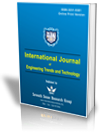Customized Deep Learning Approach for Brain Tumor Classification
Customized Deep Learning Approach for Brain Tumor Classification |
||
 |
 |
|
| © 2025 by IJETT Journal | ||
| Volume-73 Issue-11 |
||
| Year of Publication : 2025 | ||
| Author : Vikram Verma and Alankrita Aggarwal | ||
| DOI : 10.14445/22315381/IJETT-V73I11P125 | ||
How to Cite?
Vikram Verma and Alankrita Aggarwal,"Customized Deep Learning Approach for Brain Tumor Classification", International Journal of Engineering Trends and Technology, vol. 73, no. 11, pp.349-363, 2025. Crossref, https://doi.org/10.14445/22315381/IJETT-V73I11P125
Abstract
Magnetic Resonance Imaging (MRI) is widely accepted as the reference standard and a highly employed technique for brain tumor classification due to its ability to produce high-quality, non-invasive brain scans. Because tumor cells are heterogeneous, it is challenging to classify them; however, recent advancements in Machine Learning (ML) have enhanced the automation and accuracy of Brain Tumor Classification (BTC). Furthermore, with the expansion of artificial intelligence, particularly in Deep Learning (DL), a new avenue has opened, offering promising new opportunities for BT research and treatment. The objective of this research is to use multimodal images for the BTC. It specifically concentrates on MRI data collected from three different repositories. The novelty is in using these MRIs. Most of the earlier researches use single datasets or multiple datasets but applies DL individually. In this study, the MRI were mixed and then subjected to preprocessing before being used for training. The significant research gap is the absence of a unified framework for defining the most suitable neural network architecture for a given problem, which necessitates dependence on experimental trial-and-error strategies for new models. This study presents a Customized CNN (CCNN) solution for classifying 5712 brain MRI into four types. Besides CCNN, other Transfer Learning (TL) techniques like Custom VGG19 (C-VGG19), Customized MobileNet (C-MN), and customized DenseNet201 (C-DN201) are also used. According to trial data, test accuracy for the suggested CCNN was 95.80%, for C-VGG19 it was 97.02%, for C-MN it was 95.10%, and for C-DN201 it was 98.42%. DL frameworks utilizing CNN structures have been demonstrated to be highly effective for tumor classification and segmentation, successfully mitigating obstacles in MRI investigations.
Keywords
Brain Tumor, CNN, Deep Learning, Magnetic Resonance Imaging, Machine Learning.
References
[1] Arati Rath et al., “A Bibliometric Review: Brain Tumor Magnetic Resonance Imagings using Different Convolutional Neural Network Architectures,” World Neurosurgery, vol. 170, pp. e681-e694, 2023.
[CrossRef] [Google Scholar] [Publisher Link]
[2] Global Cancer Observatory, Cancer Today, International Agency for Research on Cancer, 2024. [Online]. Available: https://gco.iarc.fr/en
[3] Bjoern H. Menze et al., “The Multimodal Brain Tumor Image Segmentation Benchmark (BRATS),” IEEE Transactions on Medical Imaging, vol. 34, no. 10, pp. 1993-2024, 2015.
[CrossRef] [Google Scholar] [Publisher Link]
[4] Ashwini Pradhan et al., “On the Classification of MR Images using ‘ELM-SSA’ Coated Hybrid Model,” Mathematics, vol. 9, no. 17, pp. 1-21, 2021.
[CrossRef] [Google Scholar] [Publisher Link]
[5] Annapareddy V.N. Reddy et al., “Analyzing MRI Scans to Detect Glioblastoma Tumor using Hybrid Deep Belief Networks,” Journal of Big Data, vol. 7, no. 1, pp. 1-17, 2020.
[CrossRef] [Google Scholar] [Publisher Link]
[6] Dillip Ranjan Nayak et al., “Brain Tumour Classification using Noble Deep Learning Approach with Parametric Optimization through Metaheuristics Approaches,” Computers, vol. 11, no. 1, pp. 1-14, 2022.
[CrossRef] [Google Scholar] [Publisher Link]
[7] Qurat-Ul-Ain Mastoi et al., “Explainable AI in Medical Imaging: An Interpretable and Collaborative Federated Learning Model for Brain Tumor Classification,” Frontiers in Oncology, vol. 15, pp. 1-16, 2025.
[CrossRef] [Google Scholar] [Publisher Link]
[8] Mohsen Asghari Ilani, Dingjing Shi, and Yaser Mike Banad, “T1-Weighted MRI-Based Brain Tumor Classification using Hybrid Deep Learning Models,” Scientific Reports, vol. 15, no. 1, pp. 1-16, 2025.
[CrossRef] [Google Scholar] [Publisher Link]
[9] Md. Manowarul Islam et al., “BrainNet: Precision Brain Tumor Classification with Optimized Efficient Net Architecture,” International Journal of Intelligent Systems, vol. 2024, no. 1, pp. 1-24, 2024.
[CrossRef] [Google Scholar] [Publisher Link]
[10] Abdullah A. Asiri et al., “Enhancing Brain Tumor Diagnosis: An Optimized CNN Hyperparameter Model for Improved Accuracy And Reliability,” PeerJ Computer Science, vol. 10, pp. 1-28, 2024.
[CrossRef] [Google Scholar] [Publisher Link]
[11] Syed Ahmmed et al., “Enhancing Brain Tumor Classification with Transfer Learning across Multiple Classes: An In-Depth Analysis,” BioMedInformatics, vol. 3, no. 4, pp. 1124-1144, 2023.
[CrossRef] [Google Scholar] [Publisher Link]
[12] Josephine Nijofi Mactina, and S. Neduncheliyan, “An Towards Efficient Optimal Recurrent Neural Network-Based Brain Tumour Classification using Cat and Rat Swarm (CARS) Optimisation,” Multimedia Tools and Applications, vol. 83, no. 10, pp. 30897-30918, 2023.
[CrossRef] [Google Scholar] [Publisher Link]
[13] Rajeev Kumar Gupta et al., “Brain Tumor Detection and Classification Using Cycle Generative Adversarial Networks,” Interdisciplinary Sciences: Computational Life Sciences, vol. 14, no. 2, pp. 485-502, 2022.
[CrossRef] [Google Scholar] [Publisher Link]
[14] Francisco Javier Díaz-Pernas et al., “A Deep Learning Approach for Brain Tumor Classification and Segmentation using a Multiscale Convolutional Neural Network,” Healthcare, vol. 9, no. 2, pp. 1-14, 2021.
[CrossRef] [Google Scholar] [Publisher Link]
[15] T. Ruba et al., “Accurate Classification and Detection of Brain Cancer Cells in MRI and CT Images using Nano Contrast Agents,” Biomedical & Pharmacology Journal, vol. 13, no. 3, pp. 1227-1237, 2020.
[CrossRef] [Google Scholar] [Publisher Link]
[16] Nyoman Abiwinanda et al., “Brain Tumor Classification using Convolutional Neural Network,” World Congress on Medical Physics and Biomedical Engineering 2018, Prague, Czech Republic, pp. 183-189, 2019.
[CrossRef] [Google Scholar] [Publisher Link]
[17] Amin Kabir Anaraki, Moosa Ayati, and Foad Kazemi, “Magnetic Resonance Imaging-Based Brain Tumor Grades Classification and Grading via Convolutional Neural Networks and Genetic Algorithms,” Biocybernetics and Biomedical Engineering, vol. 39, no. 1, pp. 63-74, 2019.
[CrossRef] [Google Scholar] [Publisher Link]
[18] Parnian Afshar, Arash Mohammadi, and Konstantinos N. Plataniotis, “Brain Tumor Type Classification via Capsule Networks,” 2018 25th IEEE International Conference on Image Processing (ICIP), Athens, Greece, pp. 3129-3133, 2018.
[CrossRef] [Publisher Link]
[19] J. Seetha, and S. Selvakumar Raja, “Brain Tumor Classification using Convolutional Neural Networks,” Biomedical & Pharmacology Journal, vol. 11, no. 3, pp. 1457-1461, 2018.
[CrossRef] [Google Scholar] [Publisher Link]
[20] Rukiye Disci, Fatih Gurcan, and Ahmet Soylu, “Advanced Brain Tumor Classification in MR Images using Transfer Learning and Pre-Trained Deep CNN Models,” Cancers, vol. 17, no. 1, pp. 1-21, 2025.
[CrossRef] [Google Scholar] [Publisher Link]
[21] Anjana Bharati Subba, and Arun Kumar Sunaniya, “Computationally Optimized Brain Tumor Classification using Attention-Based GoogLeNet-Style CNN,” Expert Systems with Applications, vol. 260, 2025.
[CrossRef] [Google Scholar] [Publisher Link]
[22] Mohammad Amin et al., “DieT Transformer Model with PCA-ADE Integration for Advanced Multi-Class Brain Tumor Classification,” Intelligence-Based Medicine, vol. 11, pp. 1-11, 2025.
[CrossRef] [Google Scholar] [Publisher Link]
[23] Nadia Bibi et al., “A Transfer Learning-Based Approach for Brain Tumor Classification,” IEEE Access, vol. 12, pp. 111218-111238, 2024.
[CrossRef] [Google Scholar] [Publisher Link]
[24] Mohammed Aloraini et al., “Combining the Transformer and Convolution for Effective Brain Tumor Classification using Mri Images,” Applied Sciences, vol. 13, no. 6, pp. 1-20, 2023.
[CrossRef] [Google Scholar] [Publisher Link]
[25] Md Ishtyaq Mahmud, Muntasir Mamun, and Ahmed Abdelgawad, “A Deep Analysis of Brain Tumor Detection from MR Images using Deep Learning Networks,” Algorithms, vol. 16, no. 4, pp. 1-19, 2023.
[CrossRef] [Google Scholar] [Publisher Link]
[26] Gehad Abdullah Amran et al., “Brain Tumor Classification and Detection using Hybrid Deep Tumor Network,” Electronics, vol. 11, no. 21, pp. 1-19, 2022.
[CrossRef] [Google Scholar] [Publisher Link]
[27] Yurong Guan et al., “A Framework for Efficient Brain Tumor Classification using MRI Images,” Mathematical Biosciences and Engineering, vol. 18, no. 5, pp. 5790-5815, 2021.
[CrossRef] [Google Scholar] [Publisher Link]
[28] Neelum Noreen et al., “Brain Tumor Classification based on Fine-Tuned Models and the Ensemble Method,” Computers, Materials & Continua, vol. 67, no. 3, pp. 3967-3952, 2021.
[CrossRef] [Google Scholar] [Publisher Link]
[29] Raheleh Hashemzehi et al., “Detection of Brain Tumors from MRI Images based on Deep Learning using Hybrid Model CNN and NADE,” Biocybernetics and Biomedical Engineering, vol. 40, no. 3, pp. 1225-1232, 2020.
[CrossRef] [Google Scholar] [Publisher Link]
[30] S. Deepak, and P.M. Ameer, “Brain Tumor Classification using Deep CNN Features via Transfer Learning,” Computers in Biology and Medicine, vol. 111, 2019.
[CrossRef] [Google Scholar] [Publisher Link]
[31] Palash Ghosal et al., “Brain Tumor Classification using ResNet-101 Based Squeeze and Excitation Deep Neural Network,” 2019 Second International Conference on Advanced Computational and Communication Paradigms (ICACCP), Gangtok, India, pp. 1-6, 2019.
[CrossRef] [Google Scholar] [Publisher Link]
[32] Yufan Zhou et al., “Holistic Brain Tumor Screening and Classification based on Densenet and Recurrent Neural Network,” International MICCAI Brainlesion Workshop, Granada, Spain, pp. 208-217, 2018.
[CrossRef] [Google Scholar] [Publisher Link]
[33] Jenni A.M. Sidey-Gibbons, and Chris J. Sidey-Gibbons, “Machine Learning in Medicine: A Practical Introduction,” BMC Medical Research Methodology, vol. 19, no. 1, pp. 1-18, 2019.
[CrossRef] [Google Scholar] [Publisher Link]
[34] Shubhangi Solanki et al., “Brain Tumor Detection and Classification using Intelligence Techniques: An Overview,” IEEE Access, vol. 11, pp. 12870-12886, 2023.
[CrossRef] [Google Scholar] [Publisher Link]
[35] Emrah Irmak, “Multi-Classification of Brain Tumor MRI Images using Deep Convolutional Neural Network with Fully Optimized Framework,” Iranian Journal of Science and Technology, Transactions of Electrical Engineering, vol. 45, no. 3, pp. 1015-1036, 2021.
[CrossRef] [Google Scholar] [Publisher Link]
[36] Chirodip Lodh Choudhury et al., “Brain Tumor Detection and Classification using Convolutional Neural Network and Deep Neural Network,” 2020 International Conference on Computer Science, Engineering and Applications (ICCSEA), Gunupur, India, pp. 1-4, 2020.
[CrossRef] [Google Scholar] [Publisher Link]
[37] Wadhah Ayadi et al., “Deep CNN for Brain Tumor Classification,” Neural Processing Letters, vol. 53, no. 1, pp. 671-700, 2021.
[CrossRef] [Google Scholar] [Publisher Link]
[38] Arshia Rehman et al., “A Deep Learning-Based Framework for Automatic Brain Tumors Classification using Transfer Learning,” Circuits, Systems, and Signal Processing, vol. 39, no. 2, pp. 757-775, 2020.
[CrossRef] [Google Scholar] [Publisher Link]
[39] Hiba Mzoughi et al., “Deep Multi-Scale 3D Convolutional Neural Network (CNN) for MRI Gliomas Brain Tumor Classification,” Journal of Digital Imaging, vol. 33, no. 4, pp. 903-915, 2020.
[CrossRef] [Google Scholar] [Publisher Link]
[40] Jun Cheng, Brain Tumor Dataset, Figshare, 2017.
[CrossRef] [Publisher Link]
[41] Ahmed Hamada, Br35H: Brain Tumor Detection 2020, Kaggle Datasets, 2020.
[Publisher Link]
[42] Sartaj Bhuvaji et al., Brain Tumor Classification (MRI), Kaggle Datasets, 2020.
[Publisher Link]
[43] Zheshu Jia, and Deyun Chen, “Brain Tumor Identification and Classification of MRI Images using Deep Learning Techniques,” IEEE Access, vol. 13, pp. 123783-123792, 2020.
[CrossRef] [Google Scholar] [Publisher Link]
[44] A.R. Deepa, and W.R. Sam Emmanuel, “An Efficient Detection of Brain Tumor using Fused Feature Adaptive Firefly Backpropagation Neural Network,” Multimedia Tools and Applications, vol. 78, no. 9, pp. 11799-1181, 2019.
[CrossRef] [Google Scholar] [Publisher Link]
[45] Yun Jiang et al., “A Brain Tumor Segmentation New Method based on Statistical Thresholding and Multiscale CNN,” International Conference on Intelligent Computing, Wuhan, China, pp. 235-245, 2018.
[CrossRef] [Google Scholar] [Publisher Link]
[46] Yuexiang Li, and Linlin Shen, “Deep Learning-Based Multimodal Brain Tumor Diagnosis,” International MICCAI Brainlesion Workshop, Granada, Spain, pp. 149-158, 2018.
[CrossRef] [Google Scholar] [Publisher Link]
[47] Spyridon Bakas et al., “Advancing the Cancer Genome Atlas Glioma MRI Collections with Expert Segmentation Labels and Radiomic Features,” Nature Scientific Data, vol. 4, no. 1, pp. 1-13, 2017.
[CrossRef] [Google Scholar] [Publisher Link]
[48] Ahmed Al-Ashoor, Ferenc Lilik, and Szilvia Nagy, “A Systematic Analysis of Neural Networks, Fuzzy Logic and Genetic Algorithms in Tumor Classification,” Applied Sciences, vol. 15, no. 9, pp. 1-23, 2025.
[CrossRef] [Google Scholar] [Publisher Link]

